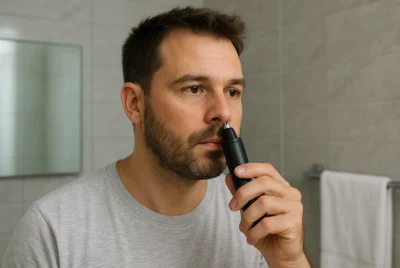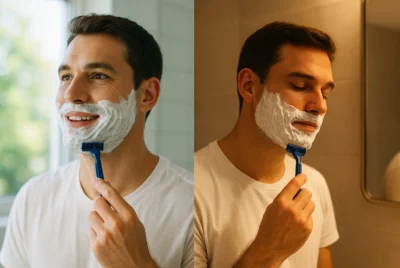Shaving Against the Grain: The Ultimate Guide
Post Disclaimer
*We may earn a commission for purchases made using our links. Please see our disclosure to learn more.
The morning ritual of shaving can make or break your day. That moment when you catch your reflection and notice stubble that should have been gone, or worse, the irritation that follows an overly aggressive shave. The debate over shaving against the grain has divided grooming enthusiasts for decades, with passionate advocates on both sides of the razor’s edge.
“The closest shave isn’t always the best shave. Understanding your hair’s natural growth pattern is the foundation of exceptional grooming.”
– Master Barber’s Handbook
Key Takeaways
- Direction matters: Shaving against the grain provides the closest shave but increases irritation risk
- Hair growth patterns vary: Understanding your unique growth direction is crucial for optimal results
- Technique is everything: Proper preparation and method can minimize adverse effects
- Skin sensitivity differs: What works for one person may cause problems for another
- Multiple passes work best: A systematic approach yields better results than aggressive single passes
Understanding Hair Growth Patterns
The foundation of any great shave lies in understanding how your facial hair grows. Hair follicles don’t follow a uniform pattern across your face – they spiral, curve, and change direction based on genetics, age, and even previous grooming habits.
Most men discover their hair grows downward on the cheeks and upward on the neck, but this varies significantly. Some experience swirling patterns around the jawline or completely opposite growth on different sides of their face. Taking time to map these patterns transforms your shaving experience from guesswork to precision.
The Science Behind Hair Growth
Facial hair emerges from follicles at specific angles determined by muscle attachments and skin tension. When you shave with the grain, you’re cutting hair in its natural lying position. Against the grain means lifting and cutting hair that wants to lay flat, which explains both the closer results and increased irritation potential.
The Case for Shaving Against the Grain
Advocates of against-the-grain shaving argue that nothing matches the smoothness achieved by this technique. When executed properly, it can provide a shave so close that stubble remains absent for significantly longer periods.
The mechanics make sense: cutting hair below skin level creates that coveted baby-smooth finish. For men with coarse or thick hair, this might be the only method that achieves satisfactory results. Professional barbers often employ this technique during straight razor shaves, though they possess years of training and premium tools.
When Against-the-Grain Works Best
Certain hair types and skin conditions favor this approach. Men with relatively straight hair growth patterns and resilient skin often experience excellent results. Those preparing for special occasions or professional photography frequently choose this method despite daily preference for gentler techniques.
The key lies in proper preparation and quality tools. Without adequate softening, lubrication, and sharp blades, against-the-grain shaving becomes an exercise in self-inflicted irritation.
The Risks and Drawbacks
Despite its effectiveness, shaving against the grain carries inherent risks that affect many men. Razor burn represents the most common complaint – that angry, red inflammation that makes you regret your morning routine. The aggressive cutting action can traumatize sensitive facial skin, leading to prolonged discomfort.
Ingrown hairs pose another significant concern. When hair is cut below skin level, it may struggle to emerge properly during regrowth, creating painful bumps and potential infections. Men with curly or coarse hair face higher risk, as their hair naturally curves back toward the skin.
Common Complications
Nicks and cuts increase dramatically when shaving against natural hair direction. The blade encounters more resistance, requiring additional pressure that compromises safety. Even experienced shavers occasionally draw blood when pushing too aggressively against the grain.
Skin sensitivity varies tremendously between individuals. What produces a perfect shave for one person might create days of irritation for another. Age, genetics, skin thickness, and even stress levels influence how your skin responds to aggressive shaving techniques.
The Three-Pass Method
Professional barbers rarely shave against the grain in a single aggressive pass. Instead, they employ a systematic three-pass approach that gradually reduces hair length while minimizing skin trauma.
The first pass always follows the grain direction, removing the majority of hair length with minimal irritation. This initial reduction makes subsequent passes more effective and comfortable. Quality lather between each pass maintains lubrication and protection.
Pass Two: Across the Grain
The second pass typically moves perpendicular to hair growth – across the grain rather than directly against it. This intermediate step further reduces hair length while maintaining reasonable comfort levels. Many men find this provides adequate closeness without the risks of full against-the-grain shaving.
Pass Three: The Final Challenge
Only after two preparatory passes should you consider going against the grain. At this point, remaining hair is minimal, and your skin has been gradually conditioned for the final assault. Light pressure becomes absolutely critical – let the sharp blade do the work rather than forcing it through resistance.
Preparation: The Foundation of Success
Successful against-the-grain shaving demands meticulous preparation that many men overlook in their morning rush. Hot water opens pores and softens hair, making it more pliable and easier to cut cleanly.
Pre-shave oils create a protective barrier between blade and skin while providing additional lubrication. Quality shaving creams or soaps generate rich, protective lather that cushions the cutting action. Cheap products often lack the protective qualities necessary for aggressive shaving techniques.
Tool Selection Matters
Sharp blades are non-negotiable when shaving against the grain. Dull blades require excessive pressure, dramatically increasing irritation and injury risk. Many experienced shavers replace blades more frequently when employing aggressive techniques.
Razor selection influences results significantly. Multi-blade cartridges can provide excellent results but may clog with longer hair. Safety razors offer superior control and blade sharpness but require more skill. Electric shavers rarely achieve the closeness possible with manual methods but minimize irritation risk.
Alternative Approaches
Many grooming experts advocate for compromise solutions that balance closeness with comfort. The across-the-grain technique mentioned earlier often provides 80% of the smoothness with significantly less irritation.
Some men discover that varying their approach based on facial areas yields optimal results. Perhaps against-the-grain works well on the cheeks but causes problems on the sensitive neck area. Customizing your technique to different zones can maximize effectiveness while minimizing discomfort.
The Gradual Approach
Beginning with gentle grain-following shaves and gradually introducing more aggressive techniques allows your skin to adapt over time. Rush this process, and you’ll likely experience the worst aspects of against-the-grain shaving without the benefits.
Skin conditioning through quality moisturizers and gentle exfoliation can improve your tolerance for aggressive shaving over time. However, some men simply have skin that will never tolerate against-the-grain techniques comfortably.
Post-Shave Care
Regardless of your shaving direction, proper aftercare determines your long-term skin health and comfort. Cold water closes pores and provides immediate soothing for irritated skin. Pat dry rather than rubbing to minimize additional trauma.
Quality aftershave balms without alcohol content provide healing moisture without the sting of traditional aftershaves. Ingredients like aloe vera, witch hazel, and natural oils promote healing while preventing bacterial infections in microscopic cuts.
Long-Term Skin Health
Daily moisturizing maintains skin flexibility and health between shaves. Well-hydrated skin tolerates aggressive shaving much better than dry, tight skin. Consider this an investment in better future shaves rather than just vanity.
Regular exfoliation removes dead skin cells that can trap emerging hairs, reducing ingrown hair frequency. However, avoid exfoliating immediately after aggressive shaving when your skin is already traumatized.
Making the Decision
The question of whether to shave against the grain ultimately depends on your individual circumstances, skin sensitivity, and personal priorities. Men with important presentations or special events might choose temporary discomfort for maximum smoothness, while daily shavers often prefer sustainable comfort.
Experiment during periods when you can afford some trial and error. Weekend mornings provide opportunities to test techniques without professional consequences if things go wrong. Keep detailed mental notes about what works and what causes problems.
Professional Guidance
Consider consulting with a professional barber for personalized advice based on your specific hair growth patterns and skin type. They can demonstrate proper techniques and recommend products suited to your needs. A single professional shave can teach you more than months of solo experimentation.
Conclusion
Shaving against the grain remains a viable technique for achieving exceptionally close shaves, but it’s not universally appropriate. Success depends on proper preparation, quality tools, gentle technique, and realistic expectations about your skin’s tolerance.
The closest shave isn’t always the best shave if it comes with days of irritation and discomfort. Finding your personal balance between closeness and comfort requires patience, experimentation, and honest assessment of your results.
Remember that shaving techniques can evolve as your skin changes with age, season, and lifestyle factors. What works perfectly today might need adjustment in the future. Stay flexible, prioritize skin health over aggressive closeness, and don’t hesitate to modify your approach when circumstances change.
Frequently Asked Questions
Q: How often can I safely shave against the grain?
A: This varies by individual skin sensitivity. Most men find daily against-the-grain shaving too irritating, while others can manage it every other day. Start with once or twice weekly and assess your skin’s response before increasing frequency.
Q: Should beginners attempt shaving against the grain?
A: No, beginners should master basic with-the-grain and across-the-grain techniques first. Develop proper lathering, pressure control, and blade angle skills before attempting more aggressive methods. This foundation prevents unnecessary irritation and builds confidence.
Q: What’s the best blade type for against-the-grain shaving?
A: Sharp, fresh blades are essential regardless of type. Safety razor enthusiasts often prefer feather or similar ultra-sharp blades, while cartridge users should replace blades more frequently. Avoid any blade that feels dull or tuggy.
Q: Can I use electric razors for against-the-grain shaving?
A: Most electric razors are designed to cut hair in multiple directions simultaneously, making traditional grain direction less relevant. However, they rarely achieve the closeness possible with manual razors when shaving against the grain.
Q: How do I treat irritation from against-the-grain shaving?
A: Apply cold water immediately after shaving, use alcohol-free aftershave balm, and avoid further shaving until irritation subsides. Aloe vera gel, hydrocortisone cream, and gentle moisturizers can provide additional relief. If irritation persists or worsens, consult a dermatologist.




